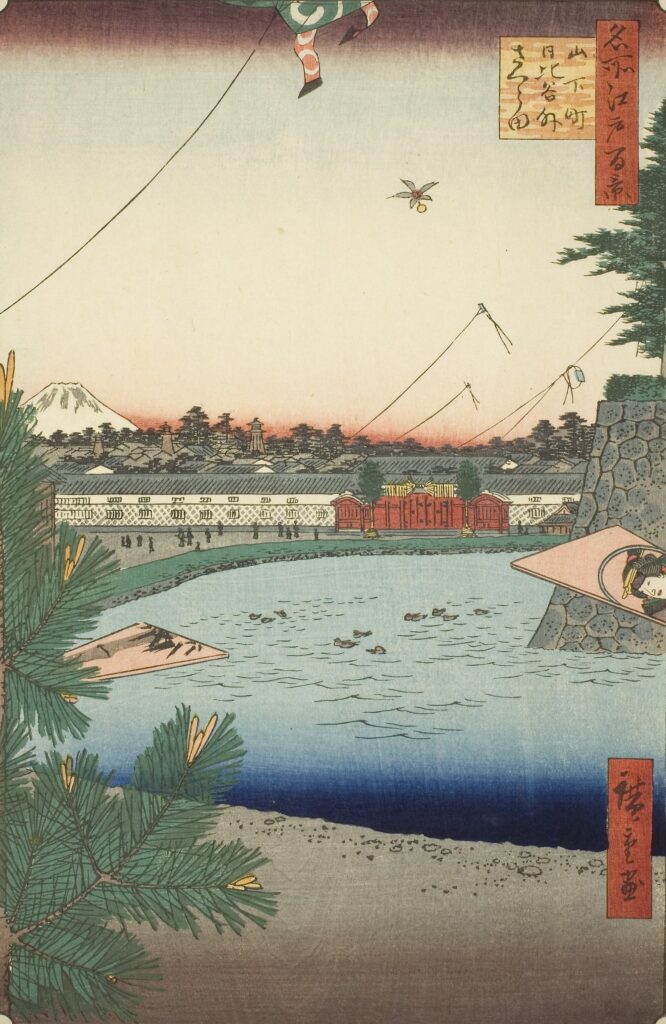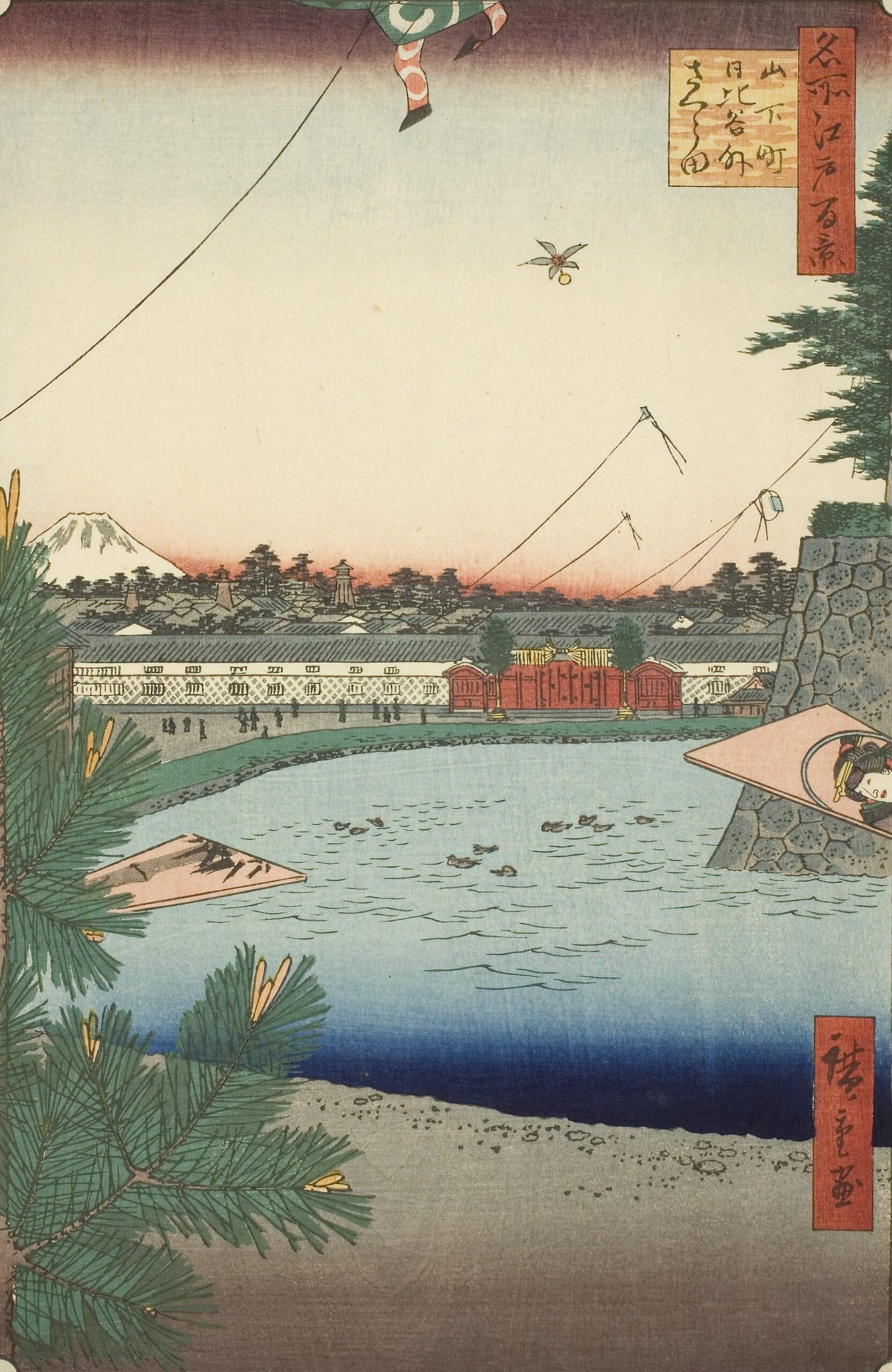
Utagawa Hiroshige – One Hundred Famous Views of Edo – 3 – Spring – Yamashitacho Hibiya Soto Sakurada (Cherry Blossom Fields in Yamashitacho and Hibiya) – Commentary 歌川広重-名所江戸百景-3-春-山下町日比谷外さくら田 解説
Current Address: Near Ginza 5-chome, Chuo Ward
Latitude and Longitude: Latitude 35.6730, Longitude 139.7586
Published: December 1857 Age: 61
Commentary
<1> Introduction
“Yamashitacho Hibiya Soto Sakurada” depicts the area around Hibiya, southwest of the outer wall of Edo Castle.
It depicts a spacious rural landscape lined with rows of cherry trees, with Edo Castle and the town in the distance.
It expresses the unique Edo landscape of harmony between nature and city.
This area, connected to the present-day Imperial Palace Outer Gardens and Hibiya Park, is a valuable illustration that reveals the area’s pre-urbanization period.
<2> About Yamashitacho Hibiya Soto Sakurada
This area is located below the Nishinomaru (West Crest) of Edo Castle, near the outer moat.
Among the many samurai residences stood fields and rows of cherry blossom trees.
The place name “Sakurada” (Sakura Fields) comes from the rows of cherry blossom trees that were lined up in the rural landscape.
In spring, the flowers bloomed in profusion, delighting the eyes of Edo’s commoners and samurai alike.
Hibiya was once a marshland near the sea.
During the construction of Edo Castle, the area was reclaimed and developed into a samurai estate and fields.
As Edo developed, this area transformed from a samurai residence town into an urban area.
In ancient times, the area was called Hime-mikado.
Later, the name was changed to Yamashita-mikado, and the area became Yamashita-cho.
<3> Highlights of the painting
In the foreground are fields, with a cherry blossom-lined avenue weaving its way through them.
A tranquil rural landscape suddenly appears in the midst of the city of Edo.
It is this contrast that made such a strong impression on the people of the time.
In the background of the canvas, the majestic Edo Castle and rows of samurai residences can be seen.
The rural cherry blossom fields and Edo Castle, a symbol of samurai society, are integrated into one landscape.
The painting captures the unique Edo landscape, where nature and authority coexisted.
Fine figures of people walking along the row of cherry trees are depicted.
In addition to commoners enjoying the blossoms, samurai and merchants passing by can also be seen, indicating that this was a space where the lives of commoners and samurai intersected.
The painting is painted in soft colors overall, evoking the joy of spring in full bloom.
The pale pink of the cherry blossoms harmonizes with the green of the fields, creating a work that allows you to fully enjoy the gentle warmth of spring.
This is the riverbank in Yamashita-cho, where townspeople lived.
Enlarged battledores are depicted on both sides in the foreground, and an oihane (flying feathers) dancing in the air on top of the center.
A large kadomatsu (new year’s pine decoration) is depicted in the lower left foreground.
The residence on the right is the upper residence of the Makino family of Kasama Domain. The long white building in the foreground is the Matsudaira (Nabeshima) clan of the Saga domain, with a fiefdom of 350,000 koku.
A fire watchtower can be seen in the center.
Yamashita Gomon Gate is on the left of the image, and Sukiyabashi Gomon Gate is to the right.
Hibiya Gomon Gate and Sakurada Gomon Gate were located on the stone wall in the foreground.
<4>The Appeal of the Edo Commoners
Cherry blossoms held a special place in the hearts of the Edo commoners.
“Sakurada” was known as a hidden cherry blossom viewing spot.
While not as large as the cherry blossom viewing spots in Ueno or on the Sumida River, the cherry blossom scenery, easily enjoyed near the castle town, was beloved by many.
Though Edo rapidly urbanized, farmland and nature remained in this area. It offered an appealing place to escape the hustle and bustle of the city and experience nature.
The view of Sakurada overlooking Edo Castle was a symbolic place where the dignity of samurai society coexisted with the enjoyment of the common people.
The depiction of Sakurada in this ukiyo-e has left a lasting impression on people as “Edo’s ideal spring scenery.”
<5>Walking through modern-day Yamashitacho and Hibiya
The depicted Sakurada area corresponds to the current Imperial Palace Outer Gardens and Hibiya Park. The lush green spaces allow visitors to enjoy nature throughout the seasons, even today.
Hibiya Park, Japan’s first modern Western-style park, is an urban oasis, filled with beautiful cherry blossoms and flowerbeds. Many people visit during the spring cherry blossom season.
Sakuradamon Gate, which formed the outer wall of Edo Castle, still remains today and is designated as an Important Cultural Property of Japan.
Famous as the site of the Sakuradamon Incident at the end of the Edo period, it is a must-see for history buffs.
The former rural landscape of the Kasumigaseki and Marunouchi areas has been transformed into a business district.
Walking around with Hiroshige’s ukiyo-e in hand, you can see traces of the past amidst the urbanization.
<6> Tourist Guide
① Strolling Through the Outer Gardens of the Imperial Palace
Relive the fields and cherry blossom-lined streets depicted by Hiroshige in a modern, lush space.
② Sakuradamon
This imposing stone gate evokes the history of Edo.
It’s also a popular photo spot.
③ Hibiya Park
In spring, the park’s cherry blossoms bloom in full, creating a landscape reminiscent of the “Sakurada” (cherry blossom fields) depicted in ukiyo-e prints.
④ Historical Strolls and Modern Architecture
Enjoy learning about the transition from the Edo period to the present day amid the government and business districts.


